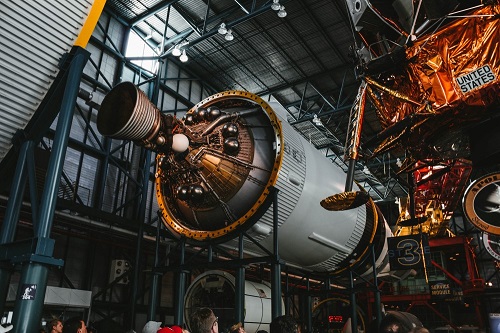The potential of 3D printing in aerospace is vast and multifaceted. It offers the ability to create lightweight, high-strength components with complex geometries that would be impossible or highly inefficient using traditional manufacturing methods. The significance of these advancements is further highlighted by the upcoming TCT Asia 2024 event, which promises to showcase the latest in 3D printing technology and its applications across various industries.

Applications of 3D Printing in Aerospace
1. Aircraft Component Manufacturing: Weight Reduction and Strength Enhancement
3D printing technology has revolutionized aircraft component manufacturing by enabling significant weight reduction and enhanced strength. This is achieved through the creation of complex geometries and lattice structures that provide the same strength as traditional designs but with less material, resulting in lighter components.
Companies like Norsk Titanium have leveraged this technology to manufacture components for Boeing's 787 Dreamliner aircraft, using their Rapid Plasma Deposition (RPD) process, which is an FAA-certified and OEM-qualified additive manufacturing technique. This process allows for the production of complex components from titanium wire, reducing lead times and costs while maintaining high standards of safety and quality.[2]
2. Aerospace Structure Manufacturing: Complex Structures and Rapid Prototyping
In the realm of aerospace structures, 3D printing has become instrumental in the manufacturing of satellites and rockets. The technology allows for rapid prototyping and the creation of intricate structures that would be challenging or impossible to produce with conventional manufacturing methods.
For instance, the European Space Agency (ESA) has utilized 3D printing to produce a CubeSat satellite structure made of PEEK plastic, showcasing the potential of additive manufacturing in space applications. Additionally, the TomskTPU-120, a satellite released by Russian astronauts, was almost entirely manufactured using 3D printing technology, highlighting the versatility and potential of this manufacturing approach in creating lightweight and durable space structures. [3]
3. Maintenance and Replacement Parts: Rapid Response and Cost-Effectiveness
3D printing technology has also transformed the maintenance, repair, and operations (MRO) sector within aerospace. The ability to quickly print replacement parts on-demand offers a rapid response to part replacement needs, reducing downtime and associated costs.
Companies like Materialise have partnered with EOS to become one of the first suppliers approved by Airbus to produce non-metallic, flame-retardant airplane spare parts using SLS (Selective Laser Sintering) technology. This collaboration has enabled the production of approximately 100 different spare parts for the Airbus A350, with a total of 26,000 parts produced annually for the A350 ecosystem.[4]
Furthermore, China Eastern Airlines has established an additive manufacturing laboratory to produce cabin interior parts, addressing the challenge of long lead times and high costs associated with traditional part replacement processes.[1]
In conclusion, 3D printing technology has become a critical component in the aerospace industry, offering innovative solutions for aircraft component manufacturing, aerospace structure creation, and efficient maintenance and replacement of parts. As the technology continues to advance, it is expected to further streamline manufacturing processes, reduce costs, and enhance the performance of aerospace vehicles and structures.

Innovative Solutions from Exhibiting Companies
BLT's innovative technologies in 3D printing aerospace components are a prime example of how this technology is being leveraged. Their metal 3D printing solutions have been instrumental in the successful launch of the Gravity-1 Y-1 rocket by Orienspace. BLT's contribution to the development of critical parts for this mission demonstrates the capability of 3D printing to meet the stringent requirements of aerospace applications.[5][6]
Anycubic, on the other hand, offers customized solutions tailored to the needs of its clients. Their product lineup includes the Wash & Cure 3, a device that streamlines post-processing by combining washing and curing functions into one machine. This not only enhances the efficiency of the 3D printing process but also ensures the highest quality finish for the final product.[7][8]
Bambu Lab has made significant breakthroughs in material development, contributing to the industry by offering a range of high-performance filaments. Their filaments are designed to meet the diverse needs of 3D printing applications, from aerospace to automotive and beyond. With detailed technical datasheets and comprehensive guides, Bambu Lab empowers users to select the best-suited material for their specific needs.[9]
3D Printing Technology Driving Industry Modernization and Efficiency
The adoption of 3D printing technology in aerospace is driving industry modernization and efficiency in several ways. It enhances design freedom and innovation capabilities by enabling the creation of complex geometries that were previously unattainable. This opens up new possibilities for optimizing component performance and reducing weight.
Additionally, 3D printing reduces production cycles and lowers costs by streamlining the manufacturing process. This is particularly beneficial for small-series production and custom parts, where traditional manufacturing methods may not be cost-effective.
Finally, 3D printing promotes sustainable development and environmental protection by reducing waste and improving material utilization. The technology's ability to create components with less material and fewer manufacturing steps contributes to a more sustainable approach to aerospace manufacturing.
As the industry continues to embrace 3D printing, events like TCT Asia 2024 play a pivotal role in showcasing the latest advancements and applications of this technology. TCT Asia 2024, which will be held at the National Exhibition and Convention Center (Shanghai) from May 7th to 9th, 2024, is set to be a premier event that brings together leading experts, exhibitors, and visitors from the 3D printing and additive manufacturing sectors. With a focus on developing a comprehensive understanding of the potential of additive manufacturing, TCT Asia 2024 aims to go beyond raising awareness by facilitating a platform for industry professionals to explore the latest innovations, share insights, and foster collaborations.

Conclusion
The integration of 3D printing technology into the aerospace industry is a testament to the power of innovation to transform traditional manufacturing practices. Companies like BLT, Anycubic, and Bambu Lab are leading the charge, providing innovative solutions that drive efficiency, enhance design capabilities, and promote sustainability. As the technology continues to evolve, it is clear that 3D printing will play an increasingly vital role in shaping the future of aerospace and beyond.
The upcoming TCT Asia 2024 event is set to be a platform for showcasing these advancements and further driving the industry forward. Please pay attention to TCTAsia’s official website and Facebook homepage for the latest information.
Foot Notes
[1]: "On-Orbit Application of Integrated 3D Printed Tank in China's Aerospace." Available at: https://blog.csdn.net/AmReference/article/details/137390154 [Accessed: April 7, 2024].
[2]: "Insights on Satellite 3D Printing Applications." Available at: http://www.3dsciencevalley.com/?p=24754 [Accessed: April 7, 2024].
[3]: "Latest 3D Printing Applications in Aviation." Available at: http://amreference.com/?p=16563 [Accessed: April 7, 2024].
[4]: "3D Printing Ignites Hope in General Aviation Equipment Innovation." Available at: https://k.sina.com.cn/article_2422410454_90630cd60010194ma.html [Accessed: April 7, 2024].
[5]: "BLT Metal 3D Printing Assists in the Successful Launch of the World's Largest Solid Rocket 'Gravity-1'." Available at: https://www.xa-blt.com/en/news/blt-metal-3d-printing-assists-in-the-successful-launch-of-the-worlds-largest-solid-rocket-gravity-1/ [Accessed: April 7, 2024].
[6]: "BLT 3D prints key components for ‘world’s largest solid rocket’." Available at: https://3dprintingindustry.com/news/blt-3d-prints-key-components-for-worlds-largest-solid-rocket-227794/ [Accessed: April 7, 2024].
[7]: "Wash & Cure 3." Available at: https://wiki.anycubic.com/en/wash-and-cure/wash-and-cure-3 [Accessed: April 7, 2024].
[8]: "Anycubic Wash and Cure Review: 2-in-1 Post-processing Solution." Available at: https://top3dshop.com/blog/anycubic-wash-and-cure-review [Accessed: April 7, 2024].
[9]: "Choose the right filament - 3D Filaments Guide for Bambu Lab Printers." Available at: https://bambulab.com/en/filament-guide [Accessed: April 7, 2024].
Join us at TCT Asia, connect with industry innovators as you explore the entire AM ecosystem including design, materials, hardware, software, post-processing, and quality. 10,000+ professionals will unite to hear about the latest trends, explore the latest immersive AM technologies and find solutions to their AM challenges.

TCT ASIA 2024
Tuesday 7th May 09:00 - 17:30
Wednesday 8th May 09:00 - 17:30
Thursday 9th May 09:00 - 15:00
NECC(Shanghai)7.1&8.1H